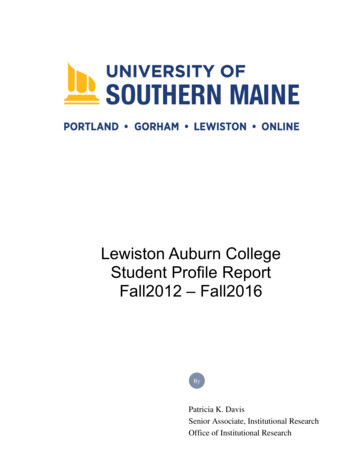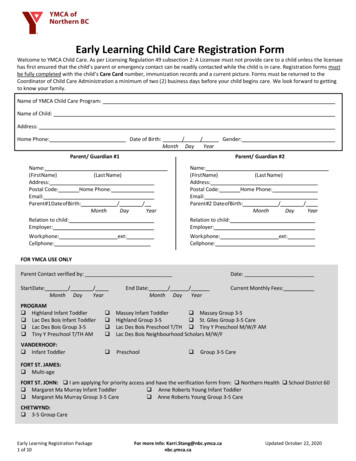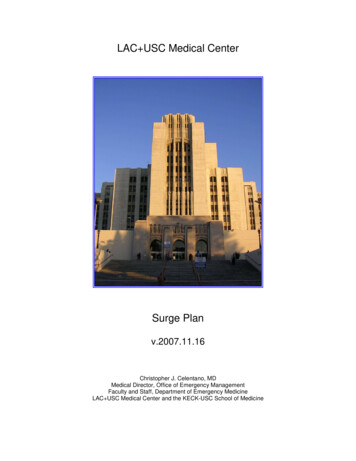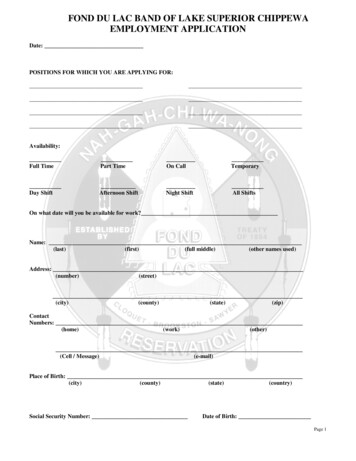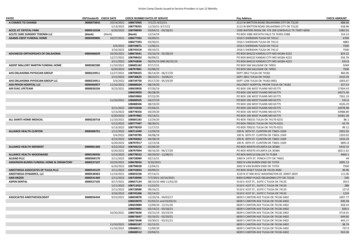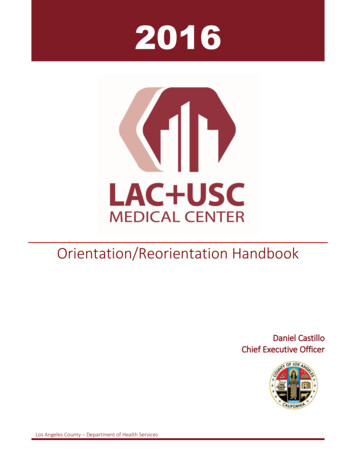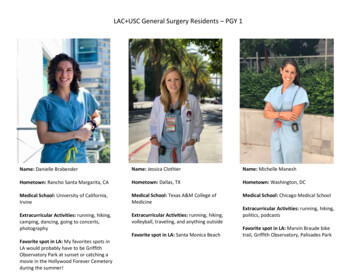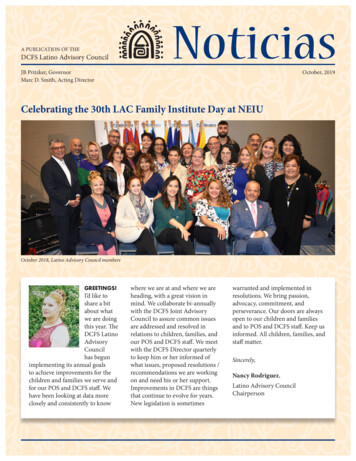
Transcription
A PUBLICATION OF THEDCFS Latino Advisory CouncilJB Pritzker, GovernorMarc D. Smith, Acting DirectorOctober, 2019Celebrating the 30th LAC Family Institute Day at NEIUOctober 2018, Latino Advisory Council membersGREETINGS!I’d like toshare a bitabout whatwe are doingthis year. TheDCFS LatinoAdvisoryCouncilhas begunimplementing its annual goalsto achieve improvements for thechildren and families we serve andfor our POS and DCFS staff. Wehave been looking at data moreclosely and consistently to knowwhere we are at and where we areheading, with a great vision inmind. We collaborate bi-annuallywith the DCFS Joint AdvisoryCouncil to assure common issuesare addressed and resolved inrelations to children, families, andour POS and DCFS staff. We meetwith the DCFS Director quarterlyto keep him or her informed ofwhat issues, proposed resolutions /recommendations we are workingon and need his or her support.Improvements in DCFS are thingsthat continue to evolve for years.New legislation is sometimes 1 warranted and implemented inresolutions. We bring passion,advocacy, commitment, andperseverance. Our doors are alwaysopen to our children and familiesand to POS and DCFS staff. Keep usinformed. All children, families, andstaff matter.Sincerely,Nancy Rodriguez,Latino Advisory CouncilChairperson
OVISORY CADOUBRATINGCELE1988302018ILNCLATINCelebrating 30 years of LAC!YEARSMiriam Mojica enjoying the Parade of FlagsKeynote Speaker Miguel Del Valle,former Illinois State SenatorDiscussion Panel: (left to right) Lourdes Rodriguez, Nancy Rodriguez, Yeni Rojas, Miriam Mojica,Evelyn Martinez, Jose Garcia, Robert Blackwell and Dr. Jean Ortega-PironLAC MEMBERSHIPOfficers:ChairpersonNancy Rodrígueznancy.rodriguez@illinois.govPast Chairperson:Juanita ulia Monzónjulia.monzon@illinois.govScribeMaría Hernándezmaria.b.hernandez@illinois.govDCFS Members:Vanessa CastroJosé R. GarcíaSydnie JuárezEvelyn MartínezAzalea MejíaTaylor PiersonBeatríz RamírezLiliana RomeroPOS Members:Patricia AguilarJennifer ContrerasLisa Marie PérezDaisy Salgado 2 Ex-officio Members:Daniel FitzgeraldChief of Affirmative ActionJosé Javier LópezOffice of Affirmative Action/Chief of Latino ServicesCommittees:Child Safety & PermanencyCommunity Risk Reduction & StaffingData Validity & DisproportionalityStrategic CommunicationsLatino Family InstituteContact Julia Monzón atjulia.monzon@illinois.govif interested in becoming a member.
Everything You Want to Know AboutBackground Checks (or Not)1981, 16 days after he disappeared. Afterhis death, his father, John Walsh, becamean avid human and victim’s rights advocateand host/creator of America’s MostWanted. On the 25th Anniversary of AdamWalsh’s abduction and murder, the AdamWalsh Act was created.By Taylor PiersonHi, my name is Taylor Pierson. I workas an office associate at DCFS in theLicensing Background Check Unit. Thishas been such an honor and blessing, butI am not here to talk about myself. Whilemost people know the basics of what we doin this unit, I am here to explain the rest.Like our name implies, we do thebackground checks for all foster homes,day care homes, and group day care homesin the state of Illinois. Our backgroundchecks go further than just Illinois StatePolice (ISP) or the Federal Bureau ofInvestigations (FBI). We also do what iscalled CANTS and SORS checks. CANTSstand for Child Abuse and NeglectTracking System, and SORS stands for SexOffender Registry Search. When we do ourCANTS searches, we search for any casesin Illinois and out of Illinois.Whenever an applicant, employee, ormember of household state on their CFS718 form (Background Authorization)that they have lived outside of Illinoisin the past three years, I will send theirinformation to the state where they livedand have them check for any abuse orneglect investigations. At that time, theother state performs an Adam Walsh checkfor Illinois. Many of you have no doubtheard of the Adam Walsh case. If you havenot heard of the case, the basics are thaton July 27th, 1981 6-year-old Adam Walshwas taken from a Sears in Hollywood, FL.After multiple failed searches for him, partof his body was recovered on August 10th,This Act is of substantial importance as itallows us to perform background checksin other state in an expeditious manner.The Adam Walsh Act is what we rely onto gather our information accurately andquickly to protect all kids in these providerhomes. While doing SORS checks, wecheck Illinois’s database as well as theUnited States Department of Justice’s DruSjodin National Sex Offender website. Thiswebsite offers us access to all registered sexoffenders in the country.Whether we do a CANTS or SORS checkon an individual, we verify all informationby name or alias, date of birth, and socialsecurity number when one is provided toshow that we have the correct person andto leave no room for errors. Our ISP andFBI checks are more self-explanatory inthe fact that they are done by the respectivegovernment agency, then the results aresent to us where we again verify name/alias, date of birth, and social securitynumber for accuracy. Now that you havean understanding about our checks, Ican give you an inside look into how weprocess our 718 forms.We have two 718 forms. Our 718-A formis used for foster home or adoptions onlywhereas the 718-B form is used for daycare homes and group day care homes. TheCFS 718-A form is also used for unlicensedadoptions and foster placements. Anytimean individual is adopting or placing inan unlicensed home, they will fill outSub-Section B in Section 1 of the 718-Aform and mark ‘For Placement Purposes’if it is for a foster placement or mark‘For Adoption Purposes’ if it is for anadoption. Once we receive this form, thefirst thing we do is add their information 3 to the IMSA/Mainframe system. We inputtheir name, aliases, DOB, address, driver’slicense, ethnicity, etc. After finishing withthat, we add them to their respectiveprovider number so they show up onthe BC-11 on our mainframe (IMSA)system. Whoever adds them is usuallythe person who will do the CANTS andSORS for that individual. Once thoseare completed, the form will be passedto another worker to do the ISP and FBIchecks. As quite of few of the licensingreps and supervisors know, whenever weneed updated ISP and FBI information,we send them off for resubmits. When thathappens we put an RS, otherwise known asa resubmit, code on their ISP, FBI, or both.We use the RS code whenever individualshave already been printed and need anupdated clearance. Then we send off someinformation to Biometric Impressionswho is our current fingerprinting providerand receive results back in a week or twoto put on the clearances. While mostcome back clear, anyone who has a ‘hit’ orcriminal background, we have to processfurther. Whoever did the backgroundcheck creates a packet to be reviewed byone of our supervisors or our specialistwho only does that. After which a notice ismade and sent to the reps and supervisors,letting them know all convictions, pendingconvictions, and non-convictions. Someconvictions are considered right off the bata bar due to the severity of the conviction.For most convictions, however, we senda recommendation for what we think,but the reps and supervisors determinewhether they will continue in the process.Another unit handles requests for NonLicensed Background Checks for otherproviders who are not licensed childwelfare agencies. That form is a 718-C butis processed much in the same way againstthe same date bases.
FYI: ICE Fact Sheet (Source: www.ice.gov)FACT SHEETICE EROPolicies and Procedures InvolvingDetained Parents and Legal GuardiansU.S. Immigration and Customs Enforcement’s (ICE) current policy and procedures address considerations when detainingand removing parents and legal guardians of minor children. These policies were first set out in the August 23, 2013directive entitled Facilitating Parental Interests in the Course of Civil Immigration Enforcement Activities, which has beenreplaced by the August 29, 2017 Directive entitled Detention and Removal of Alien Parents or Legal Guardians.Current policies and procedures governing the intake, detention, and removal of parentsand legal guardians in a number of ways, including:PLACEMENT: Making appropriate initial placement and transfer decisions for detained alien parents and legal guardians whoare identified as parties in ongoing family court or child welfare proceedings.FACILITATING PARTICIPATION IN FAMILY OR STATE COURT PROCEEDINGS: Arranging for transportation to family court or childwelfare hearings if the location is within a reasonable distance and when doing so would not be unduly burdensome or presentsecurity and/or public safety concerns. If transport is impracticable, identifying alternative means for parents to participate inhearings, such as through video or teleconference technologies.PARENT-CHILD VISITATION: In addition to following relevant ICE Detention Standards on visitation, facilitating parent-childvisitation where required by a family or dependency court or a child welfare authority.COORDINATING CARE OR TRAVEL OF CHILD: Accommodating detainees’ efforts to make care arrangements for minor childrenin the U.S. Obtaining travel documents for detainees’ minor children to accompany them to the country of removal, or toreunite in country of removal.ICE Detention StandardsALL VERSIONS OF ICE DETENTION STANDARDS REQUIRE:PHONE ACCESS: Detainees are allowed to make direct or free phone calls to immediate familyor others in personal or family emergencies or who otherwise demonstrate a compelling need(to be interpreted liberally).VISITATION FOR MINORS: Family members, including minor children, are allowed to visitrelatives in detention. Where there is no provision for visits by minors at a facility, ICE willarrange for a visit with children, stepchildren, and foster children.REQUESTS FOR TRANSFER: ICE will consider a request for transfer, when possible, to a facilitythat allows such visitation. If the transfer is not approved, or until an approved transfer can beeffected, ICE will continue to accommodate monthly visits,VISITATION HOURS: Each facility is required to set a visitation schedule based on detaineedemand that should allow for 30 minutes minimum, and more generous limits when possible,especially for family members traveling significant distances. Visitation hours on weekends andholidays are required, and some facilities may allow visits by family members outside of normalvisiting hours.Additional ResourcesCALL CENTER: The Detention Reportingand Information Line (DRIL) is a toll–freeservice that provides a direct channel fordetainees and stakeholders tocommunicate with ERO to answerquestions and resolve concerns,including separation from a child. Toreach the DRIL, call: 1-888-351-4024LOCATING A PARENT: The OnlineDetainee Locator System (ODLS) is apublic system available on the internetthat allows family members, legalrepresentatives, and members of thepublic, to locate persons who are in ICEdetention. To use ODLS, visit:https://www.ice.gov/locators. 4 Did You Know?The Performance BasedNational DetentionStandards (RevisedDecember 2016) statethat facilities should try tofacilitate contact visitationwhen possible, andshould allow detainees tosee their minor childrenas soon as possible afteradmission. Generous timeallotments for visitationwith minor children arerecommended.WEBSITE: For additional information onICE Detention Standards nds.EMAIL: For more information on thistopic, please submit inquiries toParental.Interests@ice.dhs.govMarch 2018
Guidelines For Child Welfare Agencies to Prepare ForImmigration Enforcement (Source: The Center on Immigration and Child Welfare)On August 7, 2019, U.S. Immigration andCustoms Enforcement (ICE) conductedone of the largest series of worksite raids ofits kind in almost a decade, resulting in thearrest of almost 700 individuals who workedat food processing plants in small townsnear Jackson, Mississippi. Hundreds ofthe individuals apprehended have childrenwho were left at school or without adultcare upon arriving home from school,prompting educators, child care providers,and community volunteers to find ways tocare for them. Many parents have since beenreleased from ICE custody on humanitariangrounds to continue caregiving for theirchildren, but not before their children wereleft alone overnight with no plan and, insome cases, with strangers. According to ICEofficials, 32 parents were released at theirworkplace the day of the raid in order tocontinue caring for children under the ageof 5, and roughly 270 parents were releasedwithin one day.[1],[2] Although someparents have been released, many remaindetained, robbing families of primarycaregivers and breadwinners. This suddenloss of economic and familial stability andamplified stress puts these families and theirchildren at increased risk for child welfaresystem involvement.[3]Although ICE 2009 guidelines[4] stipulatethat ICE should alert and coordinate withthe Department of Health and HumanServices (HHS) Division of ImmigrationHealth Services (DIHS) or with State andlocal social service entities (if DIHS isunavailable) before raids that will result inthe arrest of more than 25 individuals, thisdoes not always occur. The fact that a parenthas been detained by ICE should not bereason alone for children to enter custodyof the child welfare system, absent otherindications of abuse or neglect. Regardlessof whether or not they are informed priorto an enforcement operation, is essentialthat child welfare agencies are aware of theirroles in these types of situations, in order toensure the safety of children in the affectedcommunity and prevent unnecessary entryof children of immigrants into the childwelfare system. Child welfare agencies should be informedabout the Detained Parents Directive of2017, previously known as the ParentalInterest Directive, ICE Policy Number11064.2 “Detention and Removal of AlienParents and Legal Guardians,”. This policyprovides a number of standards for ICEto follow in the event that a detainedparent is also involved in child welfareproceedings. Specifically, the policystipulates that: I CE should allow parents and/orguardians to make alternative carearrangements for their children; I CE should detain parents andguardians in close proximity to theirchildren; and I CE should facilitate regular visitationbetween detained parents or guardiansand children. Child welfare agencies should establishrelationships with a point of contactat their respective ICE Field Office inorder to be prepared for immigrationenforcement operations and facilitateappropriate and timely communicationwith detained parents and relatives e.g.,about alternative care arrangements,visitation, etc. Child welfare agenciesshould ensure that their ICE point ofcontact complies with the DetainedParents Directive, specifically withprocedures on when to involve childwelfare agencies in alternative carearrangements for minor childrenencountered during enforcement actions,as detailed in Section 5.1 of the Directive. If children in immigrant families comeinto contact with the child welfare systemdue to parental detention, or if parentsor family members are detained duringthe course of a child welfare case, childwelfare agencies can use the ICE OnlineDetainee Locator to locate parents orfamily members in ICE detention in orderto connect them with their children andenable them to participate in the case.Individuals may search via the detainee’sA# (9-digit ‘alien number’ assigned byimmigration authorities) and country ofbirth, or by their first and last name andcountry of birth. Child welfare agencies can assistimmigrant parents involved in the childwelfare system in knowing their rights, 5 and they can help families locate legalresources and navigate the immigrationsystem if involved in a raid andapprehended by ICE. ACLU: Know Your Rightsprovides anoverview of immigrants’ rights and how toreduce risk in different scenarios, includingtraffic stops, home raids, and arrests nearthe border. American Immigration LawyersAssociation (AILA): Resources on Raidsincludes resources related to Know YourRights, local rapid response hotlines,detention center information, etc. Child welfare agencies, as well as otherhuman services agencies, can assist byconnecting child-welfare involved parentsand relatives to legal providers to helpprepare family safety/contingency plansand powers of attorney to establish whowill care for children in the event ofdetention and/or deportation. Women’s Refugee Commission(WRC):Resources for Families FacingDeportation and Separation a compilationof guides and resources to protect parentalrights; includes information aboutfamily separation due to detention anddeportation, safety planning, and childwelfare for families facing deportation. Appleseed Network: Protecting Assets andChild Custody in the Face of Deportationcomprehensive emergency preparednessplan for immigrant families. Child welfare agencies can partnerwith local community organizations toestablish triage and rapid response teamsto respond to crisis situations resultingfrom ICE raids. In such situations, theycan assist in locating relatives and kinto act as caregivers for children whoseparents have been detained in order toprevent the children from coming intochild welfare custody.Additional guidance and best practicesfor working with detained parents can befound in the August 2019 Immigrant LegalResource Center Toolkit on StrengtheningChild Welfare Practice for ImmigrantChildren and Families.Learn more at www.cimmcw.org
From the EditorBy Julia Monzonin the offing from one of our favoritepresenters.Hello everyone.I wanted tocontinue ourProfessional Dayfocus on self-careinto this issue ofNoticias so wehave included aresource tool for you to use for yourselfor with your clients. Look for the SelfCare Wheel on the next page. At thisyear’s Latino Institute, a morning andafternoon self-care workshop is alsoThere are several fact sheets in thisissue of Noticias. If you would like anelectronic copy please send me a requestat the email listed below.Noticias Needs You!We are looking for articles about ChildWelfare in Illinois as it relates to ourLatino population and everyone else forthat matter. We also need articles frompeople like you who attend our eventsand wish to share your experiencesand the information you learned. Thisincludes the conference today!If you like writing and would like tocontribute to the newsletter, please dropme a line at the email listed below, senda text or even make a phone call nomatter how rare those are these days. Isthere something you would like to knowmore about? Let us know, I look forwardto hearing from you!Contact:Julia Camacho ng Illinois Latino Statewide EventsDATETIMEEVENTLOCATIONORGANIZER/CONTACTOCT 1-1510:30 amLatin American Bi-National Health WeekVarious LocationsLatin-American Consulates of ChicagoOCT (TBA)10:30 amBi-National Health Week Kick Off(TBA)Latin-American Consulates of ChicagoOCT 166 pmAyudando Nuestras Familias FundraiserPerillo Chicago834 N Rush StCatholic CharitiesLatino Advisory CommitteeOCT 188:30 am –6:30 pm(PWP) Parents Working with Parents Birth ParentInstitute Day (Spanish Workshops Available)Kennedy King Chicago740 W 63rd StDCFSDevia Murray-Holmes, Arlena RoachOCT 246 pmIHCC October FiestaCarnivale, ChicagoIllinois Hispanic Chamber of CommerceNOV 26 pmDay of the Dead Ball1833 W 19th St, ChicagoNational Museum of Mexican ArtNOV 27 pm21st Annual National Cuatro FestivalHarris Theater205 E Randolph StCuatro CommitteeNOV 158 amLatino Policy Forum BreakfastChicago Union ClubLatino Policy ForumNOV 228:30 amAnnual ILLCF ConferenceStephens Convention CenterRosemont, ILIllinois Latino Legsilative Caucus Foundation2018 GalleryMartha Cerda-Babbington (center) recipient of aSpecial Recognition awardDr. Joel Savoy, Psy D (center) recipient of theCeleste Peña Award 6 Claudia Ramirez (center) wins Outstanding POSEmployee of the Year
self-carewheelSelf-Care Wheel (Source: www.olgaphoenix.gov)This Self-Care Wheel was inspiredby and adapted from“Self-Care Assessment Worksheet”from Transforming the Pain:A Workbook on VicariousTraumatization by Saakvitne,Pearlman & Sta of TSI/CAAP(Norton, 1996).Created byOlga Phoenix Project:Healing for SocialChange (2013).LIFEDedicated to alltrauma professionalsworldwide.SELF-CAREWHEEL(Also available in Spanish)BALANCEThis Self-Care Wheel was inspired by and adapted from “Self-Care Assessment Worksheet”from Transforming the Pain: A Workbook on Vicarious Traumatization by Saakvitne, Pearlman & Staffof TSI/CAAP (Norton, 1996). Created by Olga Phoenix Project: Healing for Social Change (2013).Dedicated to all trauma professionals worldwide.2018 Gallery (cont)Celmira Bolanos-Ayala (left) winsOutstanding DCFS Employee ofthe YearCarlos Colon (right) winsOutstanding Foster Parent ofthe Yearwww.OlgaPhoenix.comEloysa Velazquez (right) winsOutstanding Youth of the Year 7 Niya Kelly State Legislative Director ofthe Chicago Coalition for the Homelessaccepts the Iris and Leopoldo BurgosSocial Justice award on behalf of DirectorDoug Schenkelberg.
Service Milestones5 YEARS OF SERVICE Flor Amezcua, AuroraRogelio Guerrero Jr., AuroraRosalva Acevedo, ChicagoRobert Barasa, ChicagoGloria Ornealas, ChicagoYesenia Perez, ChicagoIsadora Reyes, ChicagoMigdalia Soto, ChicagoBert Tijerina, ChicagoSandra Aguirre-Lievano, DeerfieldAngela Moncada (Formerly DCFS)Lissette Bonilla, MaywoodOlivia Chavez, MaywoodMoises Jimenez, MaywoodAracely Madrigal, MaywoodMaria Paredes, Maywood15 YEARS OF SERVICE Orlando Arroyo, AuroraCarolina Bobo, DeerfieldIris Burgos, ChicagoMarcia Burjes, CarlinvilleJose Chacko, Glen EllynLuis Muñoz, DeKalbAda Perez-al-Muhtaseb, ChicagoSergio Valente, Glen Ellyn20 YEARS OF SERVICE Nancy Rodriguez, Chicago Emely Sanchez, Harvey25 YEARS OF SERVICE Victor Aranda, ChicagoJeanette Camarillo, DeerfieldRichard Echevarria, DeKalbCarlos Guerrero, ChicagoMarco Leonardo, DeerfieldAna Martell, ChicagoEvelyn Martinez, Glen EllynAmalia Melendez, DeerfieldSusan Mellema, ChicagoJose Oropezza, ChicagoMonica Pedigo, SpringfieldDiana Padilla, ChicagoPedro Pedraza, RockfordMartha Saines, HarveyLisa Vargas, Waukegan30 YEARS OF SERVICE Susan Alejandro, Chicago Celmira Bolanos-Ayala (Retired)35 YEARS OF SERVICE Sylvia Fonseca, Chicago Patricia Losoya, ChicagoNOTICIAS is broughtto you by the LatinoAdvisory Council andthe Illinois Departmentof Children and Family Services. Itis distributed to DCFS employees,POS agencies and agencies affiliatedwith DCFS. The newsletter includesarticles pertinent to child welfare,Latino welfare issues and DCFS/POS programs, and strives to bean informative source for staffby providing updates on newchild welfare initiatives as well asupcoming events.It is our hope to continue providingstaff with a vehicle for the sharingof information. A major part of thisendeavor is you! We are asking foryour input, submission of articles andsuggestions for improving Noticias.Articles related to your experienceswith families and personal stories arealso greatly appreciated.Please submit articles, informationabout incoming events or news to:Julia Camacho Monzón, StrategicCommunications Committee Chairjulia.monzon@illinois.gov1911 S. Indiana Ave. Chicago, IL 60616Or to any of theStrategic CommunicationCommittee members:Julia Camacho Monzón, Editor, Chair;José J. López, Final Editor, VanessaCastro, Former Scribe and ContributingWriter, Azalea Mejia, Scribe, JenniferContreras, Contributing Writer, NancyRodríguez, LAC Chair-Elect, TaylorPierson, Contributing WriterIf you would like more information orwould like to participate in one of theLAC subcommittees, please contactNancy Rodriguez, LAC Chair atnancy.rodriguez@illinois.gov or anyLAC member.Special thanks to:Bert Tijerina, graphic designer, Officeof Communications; José J. López,DCFS Office of Latino Services andDaniel Fitzgerald, Deputy Director,Office of Affirmative Action312.814.6800www2.illinois.gov/DCFSPrinted by Authority of the State of IllinoisDCFS #000 Oct 2019 000 copies rev 10/2019 8
to the IMSA/Mainframe system. We input their name, aliases, DOB, address, driver's license, ethnicity, etc. After finishing with that, we add them to their respective provider number so they show up on the BC-11 on our mainframe (IMSA) system. Whoever adds them is usually the person who will do the CANTS and SORS for that individual. Once those


